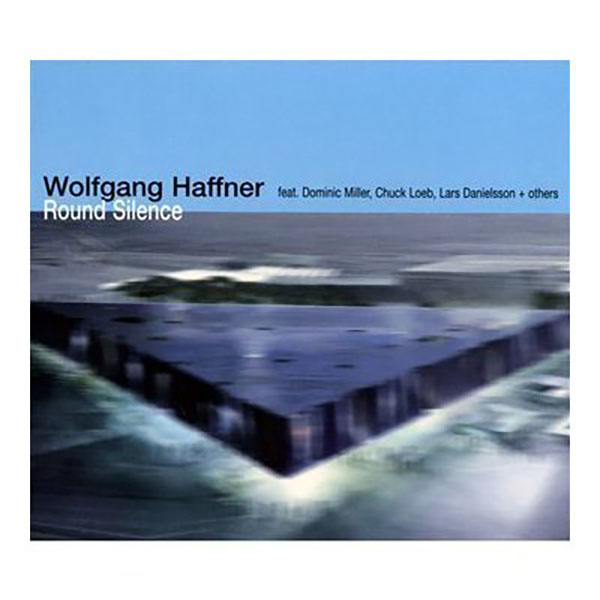
by Ian Mann
October 03, 2009
/ ALBUM
There is much to like about this album but it would be even more enjoyable if it had a few rough edges
As a sideman drummer Wolfgang Haffner has appeared on some 400 plus recordings with credits as diverse as Chaka Khan, Albert Mangelsdorff, Klaus Doldinger, Till Bronner and Nils Landgren. In 2008 he released the album “Acoustic Shapes” (also ACT), a record in the piano trio format that garnered substantial critical acclaim. Haffner’s partners on “Acoustic Shapes” were Swedish bassist Lars Danielsson and Cologne based pianist Hubert Nuss. These two musicians also appear on Haffner’s latest recording which sees him working with an extended line up and exploring the world of “Nu Jazz"as he incorporates beats and electronica into his music. This is an area Haffner has examined before with the 2005 ACT release “Shapes” which spawned a subsequent album of remixes.
“Round Silence” is a fitful record with several moments of sublime beauty but at other times the soft focus “Nu Jazz” tends towards the bland and soporific. Nevertheless we should applaud Haffner’s spirit of adventure when another piano trio disc may have represented the easy option. “Round Silence” is not a bad album and there are some real nuggets to be unearthed here.
Haffner is an undemonstrative player, this does not sound like a typical drummer’s solo album despite the fact that Haffner wrote virtually all the music. “Round Silence” is calm and unhurried, the title reflecting Haffner’s examination between music and silence, the notes and the silence surrounding them. Haffner deploys a large ensemble including horns, two bassists and a number of special guests.
The album begins superbly with the title track, an atmospheric ECM styled piece that features Danielsson’s sonorously liquid bass-sounding remarkably like Eberhard Weber- plus the delicate acoustic guitar of guesting Sting sideman Dominic Miller. Haffner maintains a steady brush led pulse , Nuss solos tastefully at the piano and trumpeter Sebastian Studnitzky helps to provide the aural backdrop.
“Left Side Of Field” is also impressive, more urgent and openly into beats (one Julian Haffner is credited with “additional percussion programming”) but the atmosphere maintained by the opener is maintained with Danielsson again prominent.
Having worked so hard to establish a mood Haffner then fractures it with the introduction of guest vocalist Kim Sanders with whom he co-wrote the song “It’s Not Safe”. Not that it’s a bad song, it just seems out of place with much of the rest of the album despite the chill out arrangement and Sanders’ calmly eloquent vocal. Studnitzky takes the instrumental honours with a breathy trumpet solo from the Eick/Henriksen/Molvaer school.
Studnitzky is also prominent on “Azul” a beat driven instrumental that strays rather too close to bland 70’s style CTI/GRP fusion for comfort. First Studnitzky is heard on trumpet, later on Fender Rhodes. It’s amiable enough but pales in comparison to the opening two numbers.
Despite the unpromising title “Stadium Jazz” actually represents something of an improvement, the trumpeter again featuring in the early stages of the tune above Haffner’s shuffling beat. There are quieter, darker interludes too and a thoughtful, lyrical solo from Nuss on acoustic piano before the piece builds again to a layered climax. This item shows Haffner and his group back at something approaching their best.
The lengthy “Nightsong” features guest guitarist Chuck Loeb. It’s an episodic piece, high on atmospherics and featuring another strong contribution from pianist Nuss. Danielsson also returns to the fore after being displaced by electric bassist Christian Diener. Loeb contributes an unhurried solo in the singing, single note style of Pat Metheny. Haffner himself comes to the fore in the tune’s final stages. Once again this is impressive stuff.
Unfortunately the following “The Space In Between” sees the music veering back into the syrupy territory occupied by “Azul”. Nuss’ piano however provides some consolation.
“Tubes” is more interesting, a piece featuring guest trombonist Nils Landgren alongside Haffner on a form of tuned percussion described as “table tubes”. Landgren is remarkably lyrical on trombone, Nuss again contributes strongly and Danielsson adds warm cello sounds. This intriguing piece makes for a very pleasant interlude.
“Ride” with it’s trumpet squiggles above a busy rhythmic undertow and cool piano chording is pleasant but inconsequential although Nuss’ piano solo briefly threatens to rescue the piece from mediocrity.
“Wordless” is more successful, a languorous ballad featuring Jorg-Achim Keller’s delicate horn arrangements and Nuss’ lyrical piano.
The closing “The Flow” occupies similar territory albeit only with the core trio. Danielsson’s bass and cello make distinctive contributions alongside Nuss’ typically thoughtful piano and Haffner’s understated drumming.
“Round Silence” has much to recommend it and of it’s eleven tracks there are more hits than misses. The playing and production standards are of the customarily high standard we have come to expect from ACT and Haffner’s drumming is imaginative, colourful, tasteful and undemonstrative. There is much to like about this album but it would be even more enjoyable if it had a few rough edges.